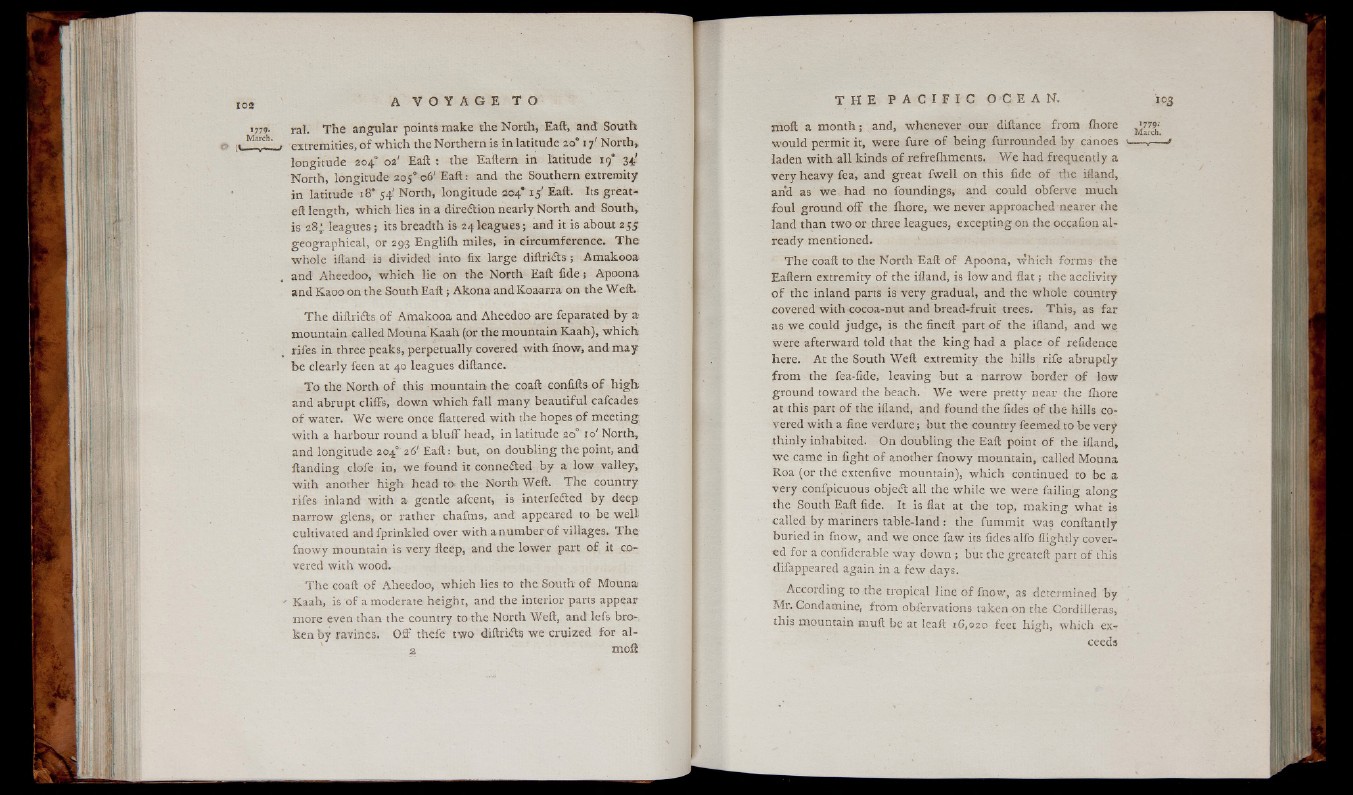
ral. T h e an g u la r points m a k e the North, Eaft, and South
extremities, o f w h ich the Northern is in latitude 20' 17' North»
long itude 204° 02' Eaft : the Eaftern. in latitude 19* 34'
North, longitude 205° 06' Eaft i and the Southern extremity
in latitude 18’ 54' North, lon g itu d e 104* 15' Eaft. Its g r e a t -
eft len gth , w h ich lies in a direction nearly North and South,
is 284 le a g u e s ; its breadth is 24 le a g u e s ; and it is about 2 5s
geographical, or 293 E n g lifti miles, in circumference. T h e
w ho le iiland is divided into fix la rg e diftrifts ; Amak ooa
and Aheedoo, w h ich lie on the North Eaft f id e ; Apoona
and Kaoo on the South E a ft; A kona and Koaarra on the Weft.
T h e diftri&s o f Amakooa and Aheedoo are feparated b y at
mountain called Mouna Kaah (or the m ountain Kaah), w h ich
rifes in three peaks, perpetually covered w ith fnow, and m a y
be clearly feen at 40 leagu es diftance.
T o the North o f this mountain the- coaft confifts o f h ig h
and abrupt cliffs, down w h ich fa ll m an y b e au tifu l cafcades
o f water. We were once flattered w ith the hopes o f meeting;
w ith a harbour round a b lu f f head, in latitude 20° 10' North,
and longitude 204° 26' E a ft, but, on doublin g the point, and
ftanding clofe in, w e found it con ne iled b y a low valley,
w ith another h ig h head to. the North Weft. T h e country
rifes inland with a gentle afcent, is in te r fe re d b y deep
narrow glens, or rather ehafms, and appeared to be w e ll
cultivated and fp rin kled over w ith an um b e r o f villa g e s . T h e
fnow y mountain is ve ry fteep, and the lowe r part o f it covered
w ith wood.
T h e coaft o f Aheedoo, w h ich lies to the South o f Mouna
Kaah, is o f a moderate h e ight, and the interior parts appear
more even than the country to the North Weft, and lefs bro-,
ken b y ravines. O ff thefe two diftrids w e c ruized fo r al-
2 m o i
moft a month ; and, when eve r our diftance from ihore
wou ld permit it, were fure o f b e in g furrounded b y canoes > .—
laden w ith a l l kinds o f refrefhments. W e had frequen tly a
v e ry h e a v y fea, and grea t fw e ll on this fide o f the ifland,
and as w e had no foundings* and could obferve much
fo u l ground o ff the ihore, w e never approached nearer the
land than two or three lea gu es, excepting on the occafion a lready
mentioned.
T h e coaft to the North Eaft o f Apoona, w h ich forms the
Eaftern extremity o f the iiland, is low and flat ; the acclivity
o f the inland parts is ve ry gradual, and the w h o le country
covered w ith cocoa-nut and bread-fruit trees. T h is , as fa r
as we could ju d g e , is the fineft part o f the iiland, and w e
were afterward told that the k in g had a place o f refidence
here. At the South Weft extremity the hills rife abruptly
from the fea-fide, lea v in g but a narrow border o f low
groun d toward the beach. We were pretty near the ihore
at this part o f the iiland, and found the iides o f the hills covered
with a fine verdure ; but the country feemed to be very
thin ly inhabited. On doub lin g the Eaft point o f the iiland,
w e came in fight o f another fn ow y mountain, called Mouna
Roa (or the extenfive mountain), w h ich continued to be a
v e ry confpicuous o b je it all the w h ile w e were failin g a long
the South Eaft fide. It is flat at the top, m a k in g what is
called by mariners table-land : the fummit was conftantly
buried in fnow, and we once faw its fides alfo flightly covered
fo r a confiderable w a y down ; but the greateft part o f this
difappeared again in a few days.
According to the tropical line o f fnow, as determined by
Mr. Condamine, from obfervations taken on the Cordilleras,
this mountain muft be at leaft 16,020 feet h igh , which exceeds